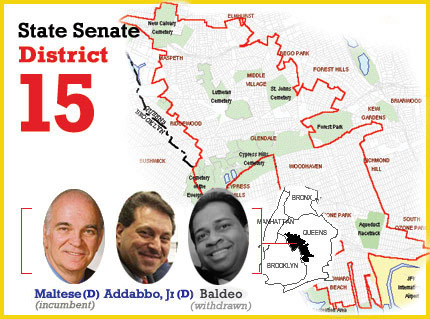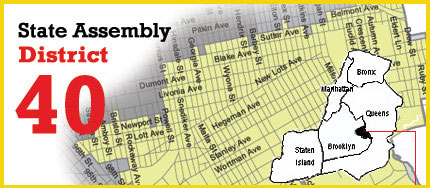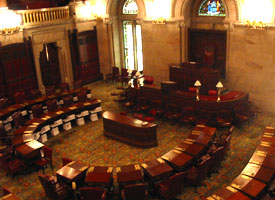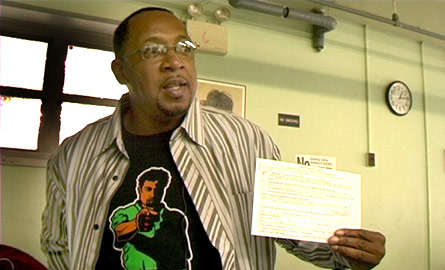
To many sitting on the concrete slab soon to be ice rink in Flushing Meadows-Corona Park's new recreation complex in Queens on Thursday afternoon, the scenery had changed, but the story seemed familiar.
Amid the sounds of planes going in or out of LaGuardia Airport every few minutes, Mayor Michael Bloomberg stood in front of the city's leaders, advocates and handpicked residents laying out his agenda for 2008. There was streamlining 911, creating a wireless system for first responders, lobbying for a DNA database, a call to keep last year's tax breaks, a charter revision and much more.
Many of the mayor's "new" ideas, though, were proposals he had made previously in some form or another, said some observers, and none had quite the impact or the buzz that the initiatives in some of his previous State of the City addresses had. There was no PlaNYC 2030. There was no overarching poverty initiative.
Could it be that Bloomberg has already tackled all of our most challenging urban issues? Has the lame duck swum his final laps? Or does the New York City mayor have his mind set on other offices?
"Keeping New York City and America at the front of the pack begins with an openness to new energy, meaning immigration, and to new ideas, meaning innovation," the mayor said. "That's how I built my business and that's the approach I've brought to a city government that was insular, and provincial and married to the conventional."
One theme did stand out during the mayor's seventh State of the City: A new urban technological revolution. It seems the technologically savvy mayor who changed the face of finance is going to continue to bring that perspective to the public sector.
A UN-BLOOMBERG AGENDA?
The mayor covered typical urban territory, from public safety to education, from government reform to the economy. While some of the proposals may be controversial, such as setting strict standards for eighth grade students to move on to high school, and others may be praised, like the transition of 311 to the Web, many already have a history in the administration.
Other more novel proposals, such as taking DNA samples from every individual who is arrested, requires the approval of state government.
Judged on policy proposals, this State of the City lacked the impact of some of Bloomberg's other major addresses. In 2007, for instance, the mayor proposed a $1 billion tax cut and several sweeping education reforms and then announced PlanNYC about ten weeks later.
"It was in a sense a consolidating speech," said Douglas Muzzio, a professor at Baruch's School of Public Affairs, of this year's State of the City. "It was a legacy ensuring speech to move things toward their conclusion."
From the New York Post, which called the speech "modest," to political observers, many saw Bloomberg's address as aimed at politics, not policy. Much of the mayor's address reminded New Yorkers of what initiatives have already been approved and are merely awaiting implementation.
"Clearly beginning the last two years of one's term, the second term of a term limit, executive lame duckness sets in, no matter how many trips you take to Austin, Texas," Muzzio added.
Others, including the reorganization of the Board of Elections, repeated proposals made last year that failed to muster support. In 2007, Bloomberg called for creating a nonpartisan board that was not directed by the influence of political party bosses. He made the same plea this year, except said the administration would work with good government group Citizens Union, whose sister organization, Citizens Union Foundation, publishes Gotham Gazette, to form a coalition that would lobby upstate for the board's overhaul.
THE TECHNOLOGY REVOLUTION
A year after Bloomberg entered office, he introduced the city's non-emergency hotline. But since then, said one official, he has not taken on technology as forcefully -- until last week.
"Up until now, he was always, through Bloomberg LP, known as the technology mayor," said Councilmember Gale Brewer, who chairs the council's Technology in Government Committee. "But he didn't have any technology, expect for 311. And today I think he changed that."
Much of the administration's plan for 2008 shifts successful initiatives of the past into a new era -- one that intends to grant citizens more access to their government through the Web, hopes to enhance public safety and improve the city's education department.
Technology and Public Safety
Many of Bloomberg's technology proposals focusing on public safety have been in the works for years, said city officials, and are just now coming to fruition. One creates a wireless system for first responders that, to the chagrin of some advocates, would be inaccessible to the public. Under the system, a fire engine heading to a blaze could call up the structure's plans from the Buildings Department while en route, thus cutting down on response time. Officials said the network, which has been being tested below Houston Street, coordinates communication among departments.
In 2008, Bloomberg said, "Digital 911" will also be kicked off, allowing New Yorkers to send photos via cellular phones to police. That proposal was in Bloomberg's speech last year. Bloomberg also plans to implement the streamlining of the entire 911 system, which will eliminate the need for operators to transfer emergency phone calls from police or fire dispatchers.
To cut down on crime, Bloomberg announced the creation of a database for firearm evidence -- the first in the nation.

Measuring Government Service
The administration's technological initiatives also focus on customer service. They would allow residents to track their 311 complaints online and create a performance reporting database to let New Yorkers track anything from response times for the Fire Department to noise complaints.
The administration will also link the internal data systems at more than a dozen city agencies, so residents will not have to give multiple agencies the same information over and over again.
That proposal, several council members said, was years in the making.
"Having those linked in some way will get people the benefits to all of which they are entitled," said Councilmember Lewis Fidler, following the mayor's address. "It is long overdue.
Tech and Education
To try to ensure that teachers are awarded tenure based on merit and not time served -- an objective of the Department of Education for the past year -- Bloomberg announced the creation of an online "tenure tool kit" for principals to measure teacher performance.
In response, Randi Weingarten, the president of the United Federation of Teachers, said, "The Web-based program ... speaks to the DOE's apparent reliance on technology to compensate for the fact that, under the current structure, there are few, if any, managers who can help principals make this decision." But, she continued, the move does not mark any shift in the city's policy on tenure.
The State of the City rolled out several other technological innovations for the Department of Education. A database on student and school progress, currently available to department employees only, will be made accessible to parents this fall. Education advocates hailed the move.
The administration's technological agenda also includes the use of global position satellite devices, currently used by first responders, to be tested on some school buses.
ECONOMIC UNCERTAINTY
Harking back to his State of the City address last year, the mayor said his preliminary budget, to be unveiled Thursday, would include several tax relief measures, including continuing the $400 rebate for homeowners and a 7 percent across-the-board tax break. But the mayor made sure to say the breaks are tentative.
"Adopting it will depend on a variety of factors unknown today -- from the health of our economy to the continued help we get from our partners in state government to the outlook for future years after our administration has come to an end," said Bloomberg.
With Wall Street volatility and an uncertain economic future, Bloomberg said his administration is committed to spending cuts announced last fall, including a 2.5 percent decrease for this fiscal year and a 5 percent decrease for fiscal year 2009 for all city agencies. (Gotham Gazette will provide coverage of the city and state budgets next week.) Those cuts respond to a looming deficit in the short term, but, according to some estimates, they may not suffice in the long-term.
This month, the city's Independent Budget Office released a report forecasting a budget gap of $3.1 billion in 2009, of $4.6 billion in 2010 and $6.3 billion in 2011.
"He already started to prepare in October for a weakening economy -- things are more or less on track with his projection back then," said Doug Turetsky, spokesman for the city's Independent Budget Office. "So rather than saying OK at this moment let's go ahead, he's saying we probably have a little more time."
Taxing and spending may also hinge on Bloomberg's future plans.
"Should he choose to run for president one would think it unlikely he would want to do so days or weeks after calling for a property tax rise, especially when he has the means to buy time before having to make either decision," Turetsky added.
Though the cuts are uncertain, many council members expressed support for the idea. "If we can do it without harming critical city agencies and slashing budgets to where we are going to lose critical services, then that's fine," said Councilmember Leroy Comrie.
CONTROVERSY ON THE HORIZON?
 Though many proposals in the State of the City quickly garner widespread support already, there are always some that spark debate. This year that could well include his proposals to eliminate so-called social promotion for eighth grade students and the establishment of a charter review commission.
Though many proposals in the State of the City quickly garner widespread support already, there are always some that spark debate. This year that could well include his proposals to eliminate so-called social promotion for eighth grade students and the establishment of a charter review commission.
Though the administration has already set promotion requirements for third, fifth and seventh grade students, the inclusion of eighth graders has caused apprehension among some advocates and officials. It comes, said Kim Sweet, the executive director of Advocates for Children, amid growing concern over middle schools in general.
"We've noticed a significant number of eighth grade students who seem to be able to get out of middle school and have nowhere to go," said Sweet. "I'm hoping that this new policy will not make this worse."
The City Council Education Committee Chair Robert Jackson also hesitated to endorse the measure, saying holding back students may not be the answer.
To commemorate the 20th anniversary of the city's largest charter review commission -- when the Board of Estimate was disbanded and the City Council was reorganized -- the mayor is commissioning another for a full "top to bottom review."
"We'll consider any proposal that will improve the life of New York and New Yorkers," Bloomberg said.
That came as a complete surprise to some City Council members, who wonder what will and won't be off limits. Will the review, for example, include the city's term limits law?
"Council members looked at one another and were like 'oh,'" said Fidler.
While the 1989 review reorganized the City Council and created the position of speaker, some members said it was unlikely the new review would increase their role -- leaving them far less powerful than the mayor.
BIGGER BATTLES
The mayor's proposal on DNA would take samples from any one who is arrested rather than only people convicted of felonies and certain types of misdemeanors. This has already elicited a backlash from civil liberties advocates. But first things first.
The proposal must be approved in Albany, and if history is any indication, it would be a hard fought battle. Last year, Gov. Eliot Spitzer could not get a similar but less sweeping initiative through the legislature.
In addition to the DNA proposal and the challenge to the Board of Elections, the mayor outlined several other initiatives whose approval rests ultimately upstate or in Washington. Among them are a gun control initiative called micro-stamping, which requires gun manufactures to produce weapons that would leave identifiable marks on shell casings. To go in effect, the concept would need an OK from the state.
A BRIGHTER FUTURE?
Whatever their likely impact, the initiatives in the State of the City may not preview what might be in store at City Hall for the next 12 months and the time left in Bloomberg's tenure -- be that two years or just one.
Some of these proposals may never be heard of again. And with the Dow Jones plummeting or rising on a daily basis, it is difficult to predict what the city could afford come June, when the City Council approves the budget.
Either way, this week's budget address is sure to shed some light on that.
"To some extent these kinds of keynote addresses always leave you saying, 'Well, lets see what happens when the budget comes out because that's one way of telling where the resources are,'" said Marilyn Hoyt, president and chief executive officer of the New York Hall of Science, who attended the mayor's State of the City. "It's a very good prelude to next week when the rubber hits the road."
Â







 Though many proposals in the State of the City quickly garner widespread support already, there are always some that spark debate. This year that could well include his proposals to eliminate so-called social promotion for eighth grade students and the establishment of a charter review commission.
Though many proposals in the State of the City quickly garner widespread support already, there are always some that spark debate. This year that could well include his proposals to eliminate so-called social promotion for eighth grade students and the establishment of a charter review commission.




